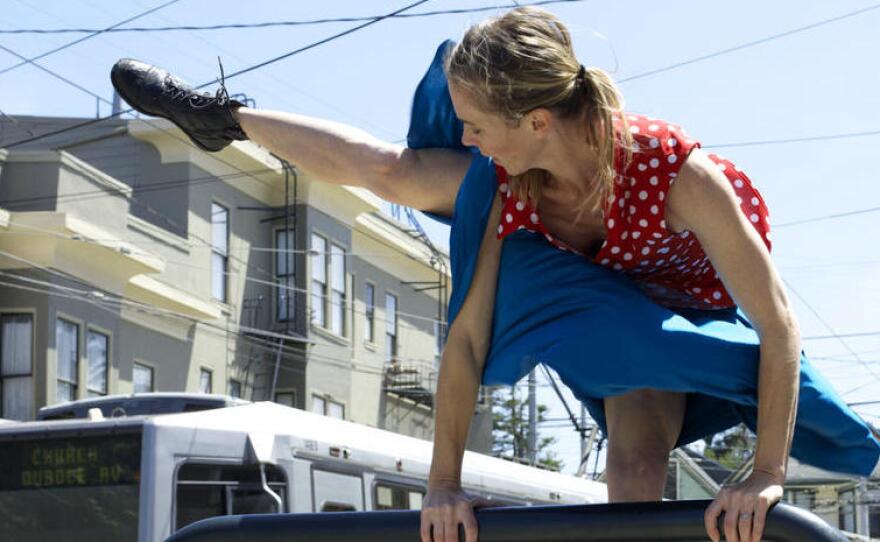San Francisco is a city known for a lot of things: cable cars, political activism, a vibrant arts scene. One annual event has been bringing these things together for 12 years now.
Every October, the free outdoor dance festival known as San Francisco Trolley Dances takes audiences on guided tours on public transit with live performance. It’s two days long, with six tours a day. On each tour, audiences ride the streetcars with a guide who brings them to various locations near MUNI stops.
At each location, a different dance group performs in a different style, from aerial to modern to hip hop. This year’s event runs along the T streetcar lines.
Choreographer Kim Epifano directs the whole event, and has since it started. She says she was inspired to start San Francisco Trolley Dances after she performed in San Diego’s event of the same name, which began as a partnership between a cash-strapped choreographer and a transit district eager for more riders.
“I thought, ‘Oh my gosh, the city of trolleys—that’s San Francisco’,” says Epifano. “Our F-line is a moving museum on wheels ... so I thought, we should do it here.”
Over Epifano’s 30-year career as a dancer and choreographer in San Francisco, she’s done stints with radical performance troupes like Dance Brigade and Contraband, making political art in the streets. So this kind of thing was right up her alley.
“I really wanted to make art that everyone could go to,” she says. “Because you’re making a stance, when you’re making site-specific work. We’re saying, ‘We are here, we’re part of this fabric of this city, and we are important.’ And so we do that by putting it in unusual places that everybody can see.”
MUNI officials don’t play an active role in the performances themselves, but the agency does provide advertising, space, and support. It’s an unlikely partnership between public art and public transit—one that Epifano says has broadened her horizons as an artist.
“The art of making the city go—those are some of my collaborators on this project, whether it’s the permit people, or MUNI, or the libraries, or you know, everything,” she says. “I feel like I’ve gotten to know those people that I might not have, if I had just stayed in the proscenium stage dance world.”
And the process of making a dance piece for a specific public space—a street corner, a library, the courtyard of an office building—means getting to know people you might otherwise pass right by.
“Security guards could get upset, or a teacher, or the cleaning person,” explains Epifano. “Or even if you’re outside, and maybe that’s some homeless person’s area. You know, it’s like the politics of the street—I’ve learned a lot. How do you be sort of polite, but also be able to be at home in that space, and make it your own?”
Epifano says it’s about building a relationship with the space itself.
“I always feel like, after I’ve done something, that’s my special place, when I go by it again. [It’s] like I have this secret for myself, in my heart … so it becomes a part of me.”
Seeing dance with new eyes
Francisco Arroliga is a computer science major at City College, and a member of the on-campus dance crew “Strong Pulse” which is performing in Trolley Dances this year. He and a partner are working on a sinuous, hip-hop-inspired dance along and on top of some long, curved stone benches. It’s a popular hangout spot at City College.
“Normally I would just come out here, we would go to the City Cafe, we would just sit there and eat lunch,” says Arroliga. “I didn’t ever think that I would dance on the place I would just sit and eat at, you know?”
Arroliga says he hopes the performances will give audiences a similar shift in perception.
“I hope that they don’t come here and just see a bench, but they actually come here and they see an actual dance. They’re able to see other aspects of the bench, not just to sit on.”
At the other end of the Trolley Dances route, on 30th Street in Noe Valley, Ramon Ramos Alayo and four of his dancers rehearse on the sidewalk in front of a colorful mural. Cuban danzón music plays from a small speaker which Alayo holds out in front of him, aiming the sound toward the dancers. They’re doing a fusion of Cuban and modern dance. Their hips switch back and forth as they execute fast and fancy footwork in their sneakers.
Alayo says site-specific work can make an audience see a place differently. And the fact that that place is outside of a theater may make audiences see dance itself differently.
“All the time, the mind is set to go to a theater to see dance performance,” Alayo says. “But right now, we’re bringing the dance to the streets. It’s free, so people can enjoy [it] more.”
Trolley Dances director Kim Epifano says she thinks putting art up front and bringing it directly to people is an important statement.
“It’s for everybody, it’s not a specific group. So it keeps the art intact in the city,” she says.
San Francisco is undergoing a dramatic transformation these days. And by strengthening people’s connections to the places where they live with projects like this, maybe art can help keep the city intact.









